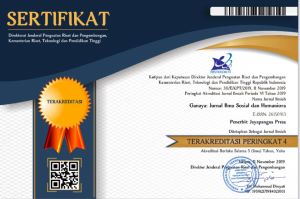Efektivitas Penggunaan Video Stop Motion Dalam Menentukan Nilai Sebagai Implementasi Pembelajaran Teks Hikayat
DOI:
https://doi.org/10.37329/cetta.v7i1.3111Keywords:
Effectiveness, Stop Motion Video, Values, Hikayat Text, LearningAbstract
The aim of this research, which was carried out using a quasi-experimental design, was to determine whether the different variables used were successful or not. This research aims to determine the effectiveness of using stop motion video in determining grades as an implementation of saga text learning in SMA/SMK/MA. This research is a quasi-experiment. The effectiveness of using stop motion video in determining grades as an implementation of saga text learning in SMA/SMK/MA between classes that were treated using stop motion video and without using stop motion video. Written tests and multiple choice exams were used to evaluate success in this research. Both the experimental class which was treated using stop motion video to determine the value of the saga, and the control class who were not treated were given this test before and after the learning process was carried out. The results of this research show that the experimental group treatment which used stop motion video to determine the value of the saga was superior to the control group treatment which did not use stop motion video.
References
Arsyad, M. N. (2018). Penerapan Media Pembelajaran Berbasis Multimedia Interaktif Terhadap Mahasiswa IKIP Budi Utomo Malang. Agastya: Jurnal Sejarah Dan Pembelajarannya, 8(2), 188-198.
Baried, S. B. (1985). Pengantar Ilmu Filologi. Jakarta: Pusat
Bella, M. A., Dacholfany, M. ihsan, & Noor, M. (2023). Peran Kepala Sekolah Sebagai Manager Dalam Meningkatkan Mutu Pendidikan Di SD Aisyiyah Poncowati. POACE: Jurnal Program Studi Adminitrasi Pendidikan, 3(2), 149–159.
Djajasudarma, T. F. (1997). Analisis Bahasa: Sintaksis Dan Semantik. Humaniora Utama Press (HUP).
Fatimah. D. (2007). Metode Linguistik: Ancangan Metode Penelitian dan Kajian. Cetakan Ketiga. Bandung: Refika Aditama.
Hamzah, A. (1996). Sastra Melayu Lama dan Raja-Rajanya. Jakarta: Dian Rakyat.
Hasliyah. (2021). Apresiasi Sastra Akhir Pekan Berbasis Paguyuban Kelas Alternatif Untuk Meningkatkan Karakter Siswa di SD Pertiwi Makassar. JIKAP PGSD: Jurnal Ilmiah Ilmu Kependidikan, Volume No.1.
Kastriani (2019) Efektivitas Penggunaan Media Pembelajaran Video Stop Motion Graphic Animation terhadap Penguasaan Konsep dan Minat Belajar Peserta Didik Kelas VIII MTs Izzatul Ma’arif Tappina. Undergraduate (S1) thesis, Universitas Islam Negeri Alauddin Makassar.
Khadijah. (2013). Hikayat Indra Budiman Telaah Nilai-Nilai Religius (Kajian Hermeneutika), Jurnal Metamorfosa. I(2)
Nurseto, S. (2012). Analisis Pengaruh Lingkungan Industri Terhadap Strategi Pemasaran Dan Dampaknya Terhadap Kinerja Pemasaran: Studi pada Usaha Kecil Kerajinan Kulit Tanggulangin. Jurnal Administrasi Bisnis, 1(1), 72-83.
Rismawati. (2017). Perkembangan Sejarah Sastra Indonesia. Banda Aceh: Bina Karya Akademika.
Sugiarto, E. (2015). Mengenal Sastra Lama (Jenis, Definisi, Ciri,Sejarah dan Contoh). Yogyakarta: Andi.
Supratman. (1996). Ikhtisar Sastra Indonesia. Bandung: Pustaka Setia
Purwanti, R., & Natanael, R. (2016). Video Animasi Stop Motion Sebagai Media Pembelajaran Pada Kampanye Pengenalan Tertib Berlalu Lintas Bagi Remaja Pengendara Sepeda Motor. Widyakala Journal: Journal Of Pembangunan Jaya University, 3, 1-8.
Downloads
Published
How to Cite
Issue
Section
License
Copyright (c) 2024 Hasminur Hasminur, Charlina Charlina, Mangatur Sinaga

This work is licensed under a Creative Commons Attribution-ShareAlike 4.0 International License.
An author who publishes in the Cetta : Jurnal Ilmu Pendidikan agrees to the following terms:
- Author retains the copyright and grants the journal the right of first publication of the work simultaneously licensed under the Creative Commons Attribution-ShareAlike 4.0 License that allows others to share the work with an acknowledgement of the work's authorship and initial publication in this journal
- Author is able to enter into separate, additional contractual arrangements for the non-exclusive distribution of the journal's published version of the work (e.g., post it to an institutional repository or publish it in a book) with the acknowledgement of its initial publication in this journal.
- Author is permitted and encouraged to post his/her work online (e.g., in institutional repositories or on their website) prior to and during the submission process, as it can lead to productive exchanges, as well as earlier and greater citation of the published work (See The Effect of Open Access).
Read more about the Creative Commons Attribution-ShareAlike 4.0 Licence here: https://creativecommons.org/licenses/by-sa/4.0/.





